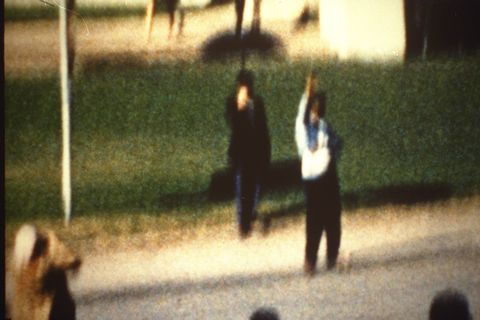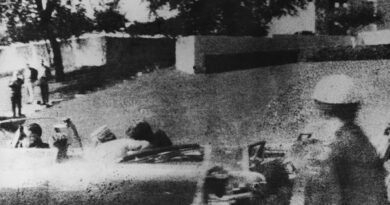True Story of the Umbrella Man at the JFK Assassination in ‘Umbrella Academy’ Season 2
Set a series called The Umbrella Academy in Dallas in the 1960s, and “the umbrella man,” a favorite subject of JFK conspiracy theorists, is bound to make an appearance. We won’t reveal any big spoilers, but a suspicious rain-gear toting fellow does indeed show up on November 22, 1963. That said, he isn’t straight out of a history book.
Once you’ve watched the time-traveling Netflix show, here’s the true story of the umbrella man:
The Umbrella Man was a man named Louie Steven Witt.
Witt says he was at Dealey Plaza the day of JFK’s assassination in 1963, with the intention of heckling Kennedy, not killing him. His umbrella, a curious accessory choice for a sunny day, was apparently intended as a reference to JFK’s father Joseph, who supported British politician Neville Chamberlain. Chamberlain, who often carried a black umbrella, was known for his policy of appeasement toward Hitler.
“Someone had mentioned that the umbrella was a sore spot with the Kennedy family,” Witt said. “Being a conservative-type fellow, I sort of placed him in the liberal camp and I was just going to do a little heckling.”
Conspiracy theorists think Witt had something to do with the assassination.
In 1978, Witt appeared in front of the House Assassinations Committee in an attempt to clear his name, and to share his experience at Dealey Plaza. “Steven Witt basically said he was a one man protestor who was at the wrong place at the wrong time,” explains Stephen Fagin, a curator at the Sixth Floor Museum at Dealey Plaza.
Witt presented his umbrella for examination, hoping to lay to rest two conspiracy theories that tied him to the murder of the President. Some theorized that he he provided a signal to the shooter, or that he fired a tranquilizer or other paralyzing weapon at Kennedy, which allowed the shooter to kill him more easily.
“I get asked about the umbrella man a lot by school kids, and I go into the ridiculousness of it, of the idea that these professional teams of assassins would choose to use a guy, very conspicuously holding up an open umbrella on a bright sunny day as a signal,” Fagin says.
“And I don’t exactly know what he would have been signaling either. The car was moving along the normal route, and could be seen a minute or more before the assassination because the motorcade makes that turn, so it would have been visible to all various gunman teams long before the umbrella man would need to raise his umbrella.”
In regards to the idea of a paralyzing dart, Fagin thinks this is “an example of is not having all the facts.” That part of the theory is based on Kennedy’s apparently stiff, slow reaction to the chaos. In the ’60s, information about Kennedy’s health was still secret. An umbrella firing a dart became an “alternative explanation” as to why Kennedy appeared to sit still during the assassination. “And so,” Fagin says, “poor Steven Witt.”
This content is imported from YouTube. You may be able to find the same content in another format, or you may be able to find more information, at their web site.
Witt died on November 17, 2014.
“I think that man went the rest of his life harassed by people who really felt that he was in some genuine way, involved in the assassination,” Fagin says. “I never had the chance to speak to him. I sent him a couple of letters trying to talk with him, but he, I don’t think, really ever spoke to anyone after testifying before the House Select Committee in the ’70s.”
This content is created and maintained by a third party, and imported onto this page to help users provide their email addresses. You may be able to find more information about this and similar content at piano.io



